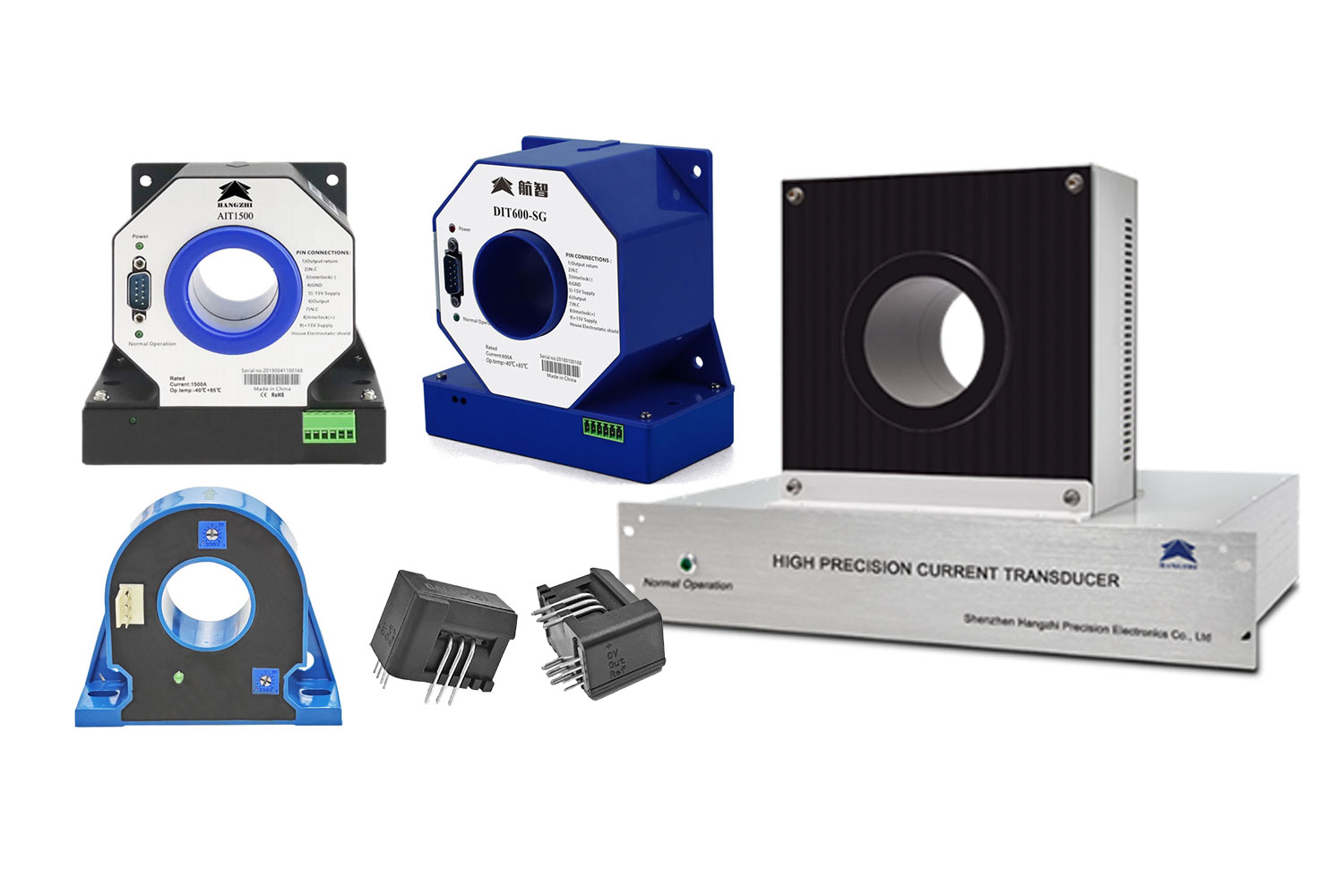
Tabla de contenido
In an increasingly electrified world, accurate power measurement is crucial for everything from optimizing energy consumption to ensuring the safety and efficiency of electrical systems.
At the heart of this accuracy lies the current transducer(current sensor), a device that has become indispensable in the fields of energy management, industrial automation, and power distribution. This blog post explores how current transducers work, the various types available, and how they improve the accuracy of power measurement.
Understanding Current Sensors
A current transducer is an electronic device that converts the current flowing through an electrical conductor into a proportional signal that can be easily measured, analyzed, or controlled. This signal is typically in the form of a voltage or current that can be read by a digital multimeter, oscilloscope, or any other data acquisition system.
Current transducers are widely used in applications where direct measurement of high currents is either impractical or dangerous. By providing an isolated, low-level signal that is proportional to the current, these devices allow for safer and more accurate power measurements.
Types of Current Sensors
There are several types of current transducers, each with its own advantages and applications. The most common types include:
Hall Effect Transducers
Hall Effect transducers operate based on the Hall Effect principle, where a magnetic field is generated by the current flowing through a conductor. This magnetic field is then detected by a Hall sensor, which produces a voltage proportional to the current. Hall Effect transducers are widely used in both AC and DC applications and are known for their ability to measure high currents with good accuracy.
Rogowski Coils
Rogowski coils are air-core coils that are used to measure alternating currents (AC). They operate on the principle of electromagnetic induction, where the changing magnetic field produced by the AC current induces a voltage in the coil. This induced voltage is proportional to the rate of change of the current, and an integrator circuit is used to convert this to a signal proportional to the actual current. Rogowski coils are highly flexible and can be easily wrapped around conductors, making them ideal for measuring currents in difficult-to-reach places.
Transformadores de corriente (CT)
Current transformers are another common type of current transducer used primarily in AC applications. They operate by inducing a secondary current in a coil that is proportional to the primary current flowing through the conductor. The secondary current is then measured and used to determine the primary current. CTs are widely used in power distribution systems and offer high accuracy, especially at high current levels.
Shunt Resistors
Shunt resistors are simple, yet effective, current transducers that operate based on Ohm’s Law. A low-resistance resistor is placed in series with the conductor, and the voltage drop across the resistor is measured. This voltage drop is directly proportional to the current flowing through the resistor. Shunt resistors are typically used for measuring DC currents and are known for their high accuracy and linearity.
Los transductores Fluxgate emplean un núcleo compuesto de un material que exhibe características de histéresis. El estado magnético del núcleo sufre alteración en respuesta a la corriente de entrada. La fluctuación magnética se reconoce y cuantifica, lo que da como resultado una salida directamente proporcional a la corriente de entrada.
Learn more about the detailed working principle of fluxgate current sensors, and the Hangzhi sensor de corriente fluxgate and tester catalog.
These sensors can be clamped onto existing electrical wiring to measure the current passing through.
How Current Sensors Improve Accuracy in Power Measurement
Current transducers play a crucial role in improving the accuracy of power measurement in several ways:
Isolation and Safety
One of the primary advantages of using current transducers is the electrical isolation they provide between the high-current carrying conductor and the measurement system. This isolation is crucial for safety, especially when dealing with high-voltage systems. It also prevents ground loops and other interference that can degrade measurement accuracy.
Minimizing Insertion Loss
Insertion loss refers to the loss of signal strength that occurs when a measuring device is introduced into a circuit. Current transducers, especially non-invasive types like Hall Effect sensors and Rogowski coils, minimize insertion loss by not interrupting the current flow. This ensures that the measurement does not affect the operation of the system being measured, thereby improving accuracy.
Wide Dynamic Range
Current transducers are capable of accurately measuring a wide range of current levels, from very low to very high. This wide dynamic range is particularly important in applications where the current can vary significantly over time. For example, in power monitoring systems, the ability to accurately measure both peak and average currents is essential for understanding power consumption patterns and identifying potential issues.
Alta linealidad
Linearity refers to the ability of a transducer to produce an output signal that is directly proportional to the input current over the entire measurement range. High linearity is essential for accurate power measurement, as it ensures that the transducer provides a true representation of the current flowing through the conductor. Modern current transducers are designed with advanced materials and construction techniques that minimize non-linearities, resulting in highly accurate measurements.
Temperature Compensation
Temperature variations can affect the accuracy of current measurements, especially in environments where the temperature fluctuates significantly. Many current transducers are equipped with temperature compensation features that adjust the output signal to account for temperature-induced errors. This ensures consistent accuracy across a wide range of operating conditions.
Noise Immunity
Electrical noise can introduce significant errors in power measurements, particularly in industrial environments where electromagnetic interference (EMI) is common. Current transducers are designed to be highly immune to noise, with features such as shielding, filtering, and differential measurement techniques. This noise immunity is crucial for maintaining accuracy in noisy environments.
Digital Signal Processing
Many modern current transducers incorporate digital signal processing (DSP) techniques to further enhance accuracy. DSP allows for real-time filtering, scaling, and correction of the transducer’s output signal, reducing errors and improving the overall accuracy of power measurement. This is particularly important in applications where precise measurement is critical, such as energy metering and power quality analysis.
Applications of Current Sensors
The accuracy improvements provided by current transducers make them essential in a wide range of applications, including:
Energy Management Systems
Accurate power measurement is crucial for energy management systems that monitor and optimize energy consumption in buildings, factories, and other facilities. Current transducers provide the precise current measurements needed to calculate power usage, identify inefficiencies, and implement energy-saving measures.
Power Quality Monitoring
Power quality monitoring systems rely on accurate current measurements to detect issues such as harmonics, voltage sags, and transients that can affect the performance of electrical equipment. Current transducers play a key role in providing the accurate data needed to diagnose and correct power quality problems.
Industrial Automation
In industrial automation, current transducers are used to monitor the performance of motors, transformers, and other electrical equipment. Accurate current measurements are essential for ensuring the safe and efficient operation of these systems, as well as for predictive maintenance and fault detection.
Renewable Energy Systems
Renewable energy systems, such as solar and wind power, require precise power measurement to maximize efficiency and ensure grid stability. Current transducers provide the accurate current measurements needed to monitor the output of renewable energy sources and manage their integration into the power grid.
Electrical Safety
In safety-critical applications, such as arc flash detection and ground fault protection, accurate current measurement is essential for preventing accidents and ensuring compliance with safety standards. Current transducers provide the precise current measurements needed to detect abnormal conditions and trigger protective actions.
Conclusión
Transductores de corriente are vital components in modern power measurement systems, providing the accuracy, safety, and reliability needed for a wide range of applications. Whether it’s optimizing energy consumption, monitoring power quality, or ensuring electrical safety, the benefits of current transducers are clear. As technology continues to advance, we can expect even greater improvements in the performance and accuracy of these essential devices, further enhancing their role in power measurement and management.
